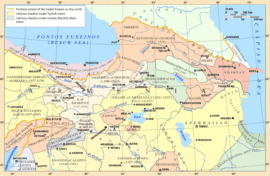Seljuq Armenia
| Armenia under the Seljuq Empire | ||||||||||||||||
| ||||||||||||||||
 Armenia, split among the Shaddadids of Ani and Gandzak, Ahlatshahs (Shah-Armen), the Saltukids of Erzurum (Karin/Theodosiopolis), the Kingdom of Syunik-Baghk, states in the Armenian Highlands during its Seljuq rule. | ||||||||||||||||
| Capital | Ani | |||||||||||||||
| Languages | Armenian (native language) Oghuz Turkic | |||||||||||||||
| Religion | Armenian Apostolic Sunni Islam | |||||||||||||||
| Government | Monarchy | |||||||||||||||
| Historical era | Middle Ages | |||||||||||||||
| • | Established | 1071 | ||||||||||||||
| • | Disestablished | 1201 | ||||||||||||||
| ||||||||||||||||
Seljuq Armenia refers to the period of Medieval Armenia under the Seljuq Empire, which began after its brief conquest by the Byzantine Empire with the fall of Bagratid Armenia in 1045 until its complete acquirement by the Kingdom of Georgia and the beginning of the Armenian-Georgian union in 1201 out of the turmoil of the fall of the Seljuq Empire in the same year.
Background
Although the native Bagratuni Dynasty was founded under favourable circumstances, the feudal system gradually weakened the country by eroding loyalty to the central government. Thus internally enfeebled, Armenia proved an easy victim for the Byzantines, who captured Ani in 1045.
Battle of Manzikert
The Seljuq dynasty under Alp Arslan took the city of Ani in 1064.[1] In 1071, after the defeat of the Byzantine forces by the Seljuq Turks at the Battle of Manzikert, the Turks captured the rest of Greater Armenia and much of Anatolia.[2] So ended Christian leadership of Armenia for the next millennium with the exception of a period of the late 12th-early 13th centuries, when the Muslim power in Greater Armenia was seriously troubled by the resurgent Georgian monarchy. Many local nobles (nakharars) joined their efforts with the Georgians, leading to liberation of several areas in northern Armenia, which was ruled, under the authority of the Georgian crown, by the Zacharids/Mkhargrdzeli, a prominent Armeno-Georgian noble family.[3]
Foreign Dominions and Beyliks
Saltukids
The Saltukids were centered in Arzan ar-Rum (Armenian: Կարին Karin, Greek: Θεοδοσιούπολις Theodosiopolis, Turkish: Erzurum) following the Battle of Manzikert, who ruled from 1071 to 1202.
Shah-Armen (Ahlatshahs)
Shah-Armens were centered in Ahlat on the northwestern shore of the Lake Van. They ruled most of modern Bitlis and Van provinces and parts of Batman, Siirt and Diyarbakır.
Shaddadids
The Shaddadids were a dynasty of Kurdish origin[4][5][6] who ruled in various parts of Armenia and Arran from 951 to 1174. They were established in Dvin. Through their long tenure in Armenia, they often intermarried with the Bagratuni royal family of Armenia.
Armenian Dominions
Kingdom of Syunik Baghk
The Kingdom of Syunik-Baghk was an Armenian state that ruled the territories of Syunik, Artsakh and Arran.
Others
Various Armenian villages and towns remained semi-independent under Armenian rule. Among these were Sassun, Moks, the Hayhurum rule of Melitene under Gabriel of Melitene, and other smaller states.
See also
References
- ↑ "Alp Arslan". Archived from the original on 2011-08-27. Retrieved February 6, 2007.
- ↑ "Byzantium and Its Influence on Neighboring Peoples". Archived from the original on 2011-08-27. Retrieved February 8, 2007.
- ↑ Dissertation, Appendix A, Supplementary Notes on the 11-13th Century Naxarars, Turco-Mongolica, History, Historical, Medieval, Armenia, Armenian, Georgia, Georgian, Mongolian,...
- ↑ Andrew C. S. Peacock, Nomadic Society and the Seljūq Campaigns in Caucasia, 209.
- ↑ Shaddadids, C.E. Bosworth, The Encyclopedia of Islam, Vol.IX, Ed. C.E.Bosworth, E. van Donzel, W.P.Heinrichs and G.Lecomte, (Brill, 1997), 169.
- ↑ Lokman I. Meho,Kelly L. Maglaughli (1968). Kurdish culture and society: an annotated bibliography. Greenwood Publishing Group. ISBN 978-0-313-31543-5.
